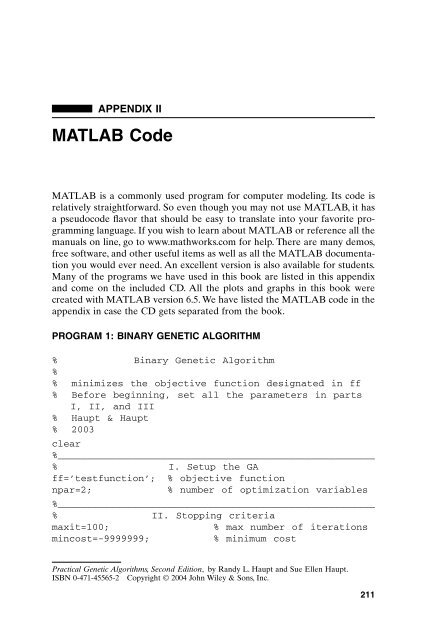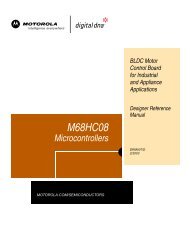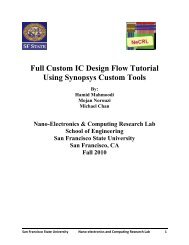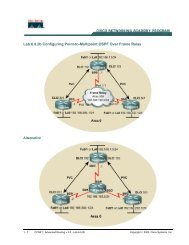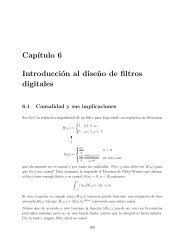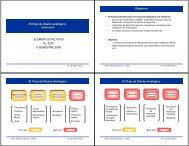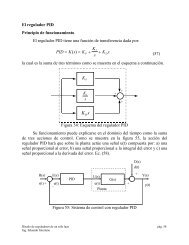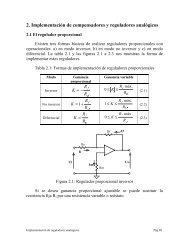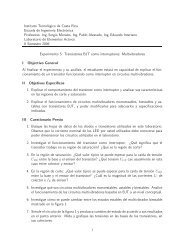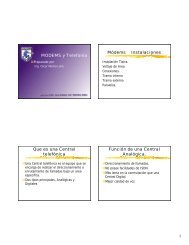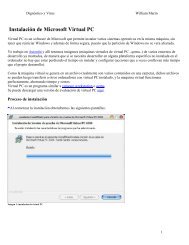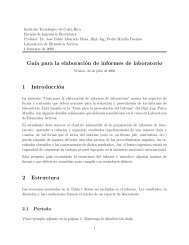MATLAB Code
MATLAB Code
MATLAB Code
Create successful ePaper yourself
Turn your PDF publications into a flip-book with our unique Google optimized e-Paper software.
APPENDIX II<br />
<strong>MATLAB</strong> <strong>Code</strong><br />
<strong>MATLAB</strong> is a commonly used program for computer modeling. Its code is<br />
relatively straightforward. So even though you may not use <strong>MATLAB</strong>, it has<br />
a pseudocode flavor that should be easy to translate into your favorite programming<br />
language. If you wish to learn about <strong>MATLAB</strong> or reference all the<br />
manuals on line, go to www.mathworks.com for help. There are many demos,<br />
free software, and other useful items as well as all the <strong>MATLAB</strong> documentation<br />
you would ever need. An excellent version is also available for students.<br />
Many of the programs we have used in this book are listed in this appendix<br />
and come on the included CD. All the plots and graphs in this book were<br />
created with <strong>MATLAB</strong> version 6.5. We have listed the <strong>MATLAB</strong> code in the<br />
appendix in case the CD gets separated from the book.<br />
PROGRAM 1: BINARY GENETIC ALGORITHM<br />
% Binary Genetic Algorithm<br />
%<br />
% minimizes the objective function designated in ff<br />
% Before beginning, set all the parameters in parts<br />
I, II, and III<br />
% Haupt & Haupt<br />
% 2003<br />
clear<br />
%_______________________________________________________<br />
% I. Setup the GA<br />
ff=’testfunction’; % objective function<br />
npar=2; % number of optimization variables<br />
%_______________________________________________________<br />
% II. Stopping criteria<br />
maxit=100; % max number of iterations<br />
mincost=-9999999; % minimum cost<br />
Practical Genetic Algorithms, Second Edition, by Randy L. Haupt and Sue Ellen Haupt.<br />
ISBN 0-471-45565-2 Copyright © 2004 John Wiley & Sons, Inc.<br />
211
212 <strong>MATLAB</strong> CODE<br />
%_______________________________________________________<br />
% III. GA parameters<br />
popsize=16; % set population size<br />
mutrate=.15; % set mutation rate<br />
selection=0.5; % fraction of population<br />
% kept<br />
nbits=8; % number of bits in each<br />
% parameter<br />
Nt=nbits*npar; % total number of bits<br />
% in a chormosome<br />
keep=floor(selection*popsize); % #population members<br />
% that survive<br />
%_______________________________________________________<br />
% Create the initial population<br />
iga=0; % generation counter<br />
% initialized<br />
pop=round(rand(popsize,Nt)); % random population of<br />
% 1s and 0s<br />
par=gadecode(pop,0,10,nbits); % convert binary to<br />
% continuous values<br />
cost=feval(ff,par); % calculates population<br />
% cost using ff<br />
[cost,ind]=sort(cost); % min cost in element 1<br />
par=par(ind,:);pop=pop(ind,:); % sorts population with<br />
% lowest cost first<br />
minc(1)=min(cost); % minc contains min of<br />
% population<br />
meanc(1)=mean(cost); % meanc contains mean<br />
% of population<br />
%_______________________________________________________<br />
% Iterate through generations<br />
while iga
PROGRAM I: BINARY GENETIC ALGORTHIM 213<br />
pick1=rand(1,M); % mate #1<br />
pick2=rand(1,M); % mate #2<br />
% ma and pa contain the indicies of the chromosomes<br />
% that will mate<br />
ic=1;<br />
while ic
214 <strong>MATLAB</strong> CODE<br />
%_______________________________________________________<br />
% Sort the costs and associated parameters<br />
[cost,ind]=sort(cost);<br />
par=par(ind,:); pop=pop(ind,:);<br />
%_______________________________________________________<br />
% Do statistics for a single nonaveraging run<br />
minc(iga+1)=min(cost);<br />
meanc(iga+1)=mean(cost);<br />
%_______________________________________________________<br />
% Stopping criteria<br />
if iga>maxit | cost(1)
PROGRAM 2: CONVERTS BINARY CHROMOSOME TO<br />
CONTINUOUS VARIABLES<br />
% gadecode.m<br />
% Decodes binary encripted parameters<br />
%<br />
% f=gadecode(chrom,lo,hi,bits,gray)<br />
% chrom = population<br />
% lo = minimum parameter value<br />
% hi = maximum parameter value<br />
% bits = number of bits/parameter<br />
% Haupt & Haupt<br />
% 2003<br />
function f=gadecode(chrom,lo,hi,bits)<br />
PROGRAM 3: CONTINUOUS GENETIC ALGORITHM 215<br />
[M,N]=size(chrom);<br />
npar=N/bits; % number of variables<br />
quant=(0.5.^[1:bits]’); % quantization levels<br />
quant=quant/sum(quant); % quantization levels<br />
normalized<br />
ct=reshape(chrom’,bits,npar*M)’;% each column contains<br />
% one variable<br />
par=((ct*quant)*(hi-lo)+lo); % DA conversion and<br />
% unnormalize varaibles<br />
f=reshape(par,npar,M)’; % reassemble population<br />
PROGRAM 3: CONTINUOUS GENETIC ALGORITHM<br />
% Continuous Genetic Algorithm<br />
%<br />
% minimizes the objective function designated in ff<br />
% Before beginning, set all the parameters in parts<br />
% I, II, and III<br />
% Haupt & Haupt<br />
% 2003<br />
%_______________________________________________________<br />
% I Setup the GA<br />
ff=’testfunction’; % objective function<br />
npar=2; % number of optimization variables<br />
varhi=10; varlo=0; % variable limits
216 <strong>MATLAB</strong> CODE<br />
%_______________________________________________________<br />
% II Stopping criteria<br />
maxit=100; % max number of iterations<br />
mincost=-9999999; % minimum cost<br />
%_______________________________________________________<br />
% III GA parameters<br />
popsize=12; % set population size<br />
mutrate=.2; % set mutation rate<br />
selection=0.5; % fraction of population kept<br />
Nt=npar; % continuous parameter GA Nt=#variables<br />
keep=floor(selection*popsize); % #population<br />
% members that survive<br />
nmut=ceil((popsize-1)*Nt*mutrate); % total number of<br />
% mutations<br />
M=ceil((popsize-keep)/2); % number of matings<br />
%_______________________________________________________<br />
% Create the initial population<br />
iga=0; % generation counter<br />
initialized<br />
par=(varhi-varlo)*rand(popsize,npar)+varlo; % random<br />
cost=feval(ff,par); % calculates population cost<br />
% using ff<br />
[cost,ind]=sort(cost); % min cost in element 1<br />
par=par(ind,:); % sort continuous<br />
minc(1)=min(cost); % minc contains min of<br />
meanc(1)=mean(cost); % meanc contains mean of<br />
population<br />
%_______________________________________________________<br />
% Iterate through generations<br />
while iga
PROGRAM 3: CONTINUOUS GENETIC ALGORITHM 217<br />
% ma and pa contain the indicies of the chromosomes<br />
% that will mate<br />
ic=1;<br />
while ic
218 <strong>MATLAB</strong> CODE<br />
for ii=1:nmut<br />
par(mrow(ii),mcol(ii))=(varhi-varlo)*rand+varlo;<br />
% mutation<br />
end % ii<br />
%_______________________________________________________<br />
% The new offspring and mutated chromosomes are<br />
% evaluated<br />
cost=feval(ff,par);<br />
%_______________________________________________________<br />
% Sort the costs and associated parameters<br />
[cost,ind]=sort(cost);<br />
par=par(ind,:);<br />
%_______________________________________________________<br />
% Do statistics for a single nonaveraging run<br />
minc(iga+1)=min(cost);<br />
meanc(iga+1)=mean(cost);<br />
%_______________________________________________________<br />
% Stopping criteria<br />
if iga>maxit | cost(1)
figure(24)<br />
iters=0:length(minc)-1;<br />
plot(iters,minc,iters,meanc,’–’);<br />
xlabel(‘generation’);ylabel(‘cost’);<br />
text(0,minc(1),’best’);text(1,minc(2),’population<br />
average’)<br />
PROGRAM 4: PARETO GENETIC ALGORITHM<br />
PROGRAM 4: PARETO GENETIC ALGORITHM 219<br />
% Pareto Genetic Algorithm<br />
%<br />
% minimizes the objective function designated in ff<br />
% All optimization variables are normalized between 0<br />
% and 1.<br />
% ff must map variables to actual range<br />
% Haupt & Haupt<br />
% 2003<br />
%_______________________________________________________<br />
% Setup the GA<br />
ff=’testfunction’; % objective function<br />
npar=4; % number of optimization variables<br />
%_______________________________________________________<br />
% Stopping criteria<br />
maxit=50; % max number of iterations<br />
mincost=.001; % minimum cost<br />
%_______________________________________________________<br />
% GA parameters<br />
selection=0.5; % fraction of population kept<br />
popsize=100;<br />
keep=selection*popsize;<br />
M=ceil((popsize-keep)/2); % number of matings<br />
odds=1;<br />
for ii=2:keep<br />
odds=[odds ii*ones(1,ii)];<br />
end<br />
odds=keep+1-odds;<br />
Nodds=length(odds);<br />
mutrate=0.1; % mutation rate
220 <strong>MATLAB</strong> CODE<br />
%_______________________________________________________<br />
% Create the initial population<br />
iga=0; % generation counter initialized<br />
pop=rand(popsize,npar); % random population of<br />
% continuous values<br />
fout=feval(ff,pop); % calculates population cost<br />
% using ff<br />
%_______________________________________________________<br />
% Iterate through generations<br />
while iga
ma(ib)=picks(pt(ib),ib);<br />
end<br />
picks=ceil(keep*rand(Ntourn,M));<br />
[c,pt]=min(cost(picks));<br />
for ib=1:M<br />
pa(ib)=picks(pt(ib),ib);<br />
end<br />
PROGRAM 4: PARETO GENETIC ALGORITHM 221<br />
%_______________________________________________________<br />
% Performs mating<br />
ix=1:2:keep; % index of mate #1<br />
xp=floor(rand(1,M)*npar); % crossover point<br />
r=rand(1,M); % mixing parameter<br />
xy=pop(ma+popsize*xp)-pop(pa+popsize*xp);<br />
% mix from ma and pa<br />
pop(keep+ix+popsize*xp)=pop(ma+popsize*xp)-r.*xy;<br />
% 1st offspring<br />
pop(keep+ix+1+popsize*xp)=pop(pa+popsize*xp)+r.*xy;<br />
% 2nd offspring<br />
for ic=1:M/2<br />
if xp(ic)
222 <strong>MATLAB</strong> CODE<br />
if row(ic)>keep;break;end<br />
if row(ic)>rowmut(iq)<br />
iq=iq+1; rowmut(iq)=row(ic);<br />
end<br />
end<br />
if rowmut(1)==0;rowmut=rowmut(2:length(rowmut));end<br />
fout(rowmut,:)=feval(ff,pop(rowmut,:));<br />
fout(keep+1:popsize,:)=feval(ff,pop(keep+1:popsize,:));<br />
fout(keep+1:popsize,:)=feval(ff,pop(keep+1:popsize,:));<br />
%_______________________________________________________<br />
% Stopping criteria<br />
if iga>maxit<br />
break<br />
end<br />
[iga cost(1) fout(1,:)]<br />
end %iga<br />
%_______________________________________________________<br />
% Displays the output<br />
day=clock;<br />
disp(datestr(datenum(day(1),day(2),day(3),day(4),day(<br />
5),day(6)),0))<br />
disp([‘optimized function is ‘ ff])<br />
format short g<br />
disp([‘popsize = ‘ num2str(popsize) ‘ mutrate = ‘<br />
num2str(mutrate) ‘ # par = ‘ num2str(npar)])<br />
disp([‘Pareto front’])<br />
disp([num2str(pop)])<br />
disp(‘continuous parameter genetic algorithm’)<br />
PROGRAM 5: PERMUTATION GENETIC ALGORITHM<br />
% Genetic Algorithm for permuation problems<br />
%<br />
% minimizes the objective function designated in ff<br />
clear<br />
global iga x y<br />
% Haupt & Haupt<br />
% 2003
PROGRAM 5: PERMUTATION GENETIC ALGORITHM 223<br />
%_______________________________________________________<br />
% Setup the GA<br />
ff=’tspfun’; % objective function<br />
npar=20; % # optimization variables<br />
Nt=npar; % # columns in population matrix<br />
rand(‘state’,3)<br />
x=rand(1,npar);y=rand(1,npar); % cities are at<br />
% (xcity,ycity)<br />
%_______________________________________________________<br />
% Stopping criteria<br />
maxit=10000; % max number of iterations<br />
%_______________________________________________________<br />
% GA parameters<br />
popsize=20; % set population size<br />
mutrate=.1; % set mutation rate<br />
selection=0.5; % fraction of population kept<br />
keep=floor(selection*popsize); % #population members<br />
% that survive<br />
M=ceil((popsize-keep)/2); % number of matings<br />
odds=1;<br />
for ii=2:keep<br />
odds=[odds ii*ones(1,ii)];<br />
end<br />
Nodds=length(odds);<br />
%_______________________________________________________<br />
% Create the initial population<br />
iga=0; % generation counter initialized<br />
for iz=1:popsize<br />
pop(iz,:)=randperm(npar); % random population<br />
end<br />
cost=feval(ff,pop); % calculates population cost<br />
% using ff<br />
[cost,ind]=sort(cost); % min cost in element 1<br />
pop=pop(ind,:); % sort population with lowest<br />
% cost first<br />
minc(1)=min(cost); % minc contains min of<br />
% population<br />
meanc(1)=mean(cost); % meanc contains mean of population
224 <strong>MATLAB</strong> CODE<br />
%_______________________________________________________<br />
% Iterate through generations<br />
while iga
temp=pop(row1,col1);<br />
pop(row1,col1)=pop(row1,col2);<br />
pop(row1,col2)=temp;<br />
im(ic)=row1;<br />
end<br />
cost=feval(ff,pop);<br />
%_______________________________________________________<br />
% Sort the costs and associated parameters<br />
part=pop; costt=cost;<br />
[cost,ind]=sort(cost);<br />
pop=pop(ind,:);<br />
%_______________________________________________________<br />
% Do statistics<br />
minc(iga)=min(cost);<br />
meanc(iga)=mean(cost);<br />
end %iga<br />
PROGRAM 5: PERMUTATION GENETIC ALGORITHM 225<br />
%_______________________________________________________<br />
% Displays the output<br />
day=clock;<br />
disp(datestr(datenum(day(1),day(2),day(3),day(4),day(<br />
5),day(6)),0))<br />
disp([‘optimized function is ‘ ff])<br />
format short g<br />
disp([‘popsize = ‘ num2str(popsize) ‘ mutrate = ‘<br />
num2str(mutrate) ‘ # par = ‘ num2str(npar)])<br />
disp([‘ best cost=’ num2str(cost(1))])<br />
disp([‘best solution’])<br />
disp([num2str(pop(1,:))])<br />
figure(2)<br />
iters=1:maxit;<br />
plot(iters,minc,iters,meanc,’––’);<br />
xlabel(‘generation’);ylabel(‘cost’);<br />
figure(1);plot([x(pop(1,:)) x(pop(1,1))],[y(pop(1,:))<br />
y(pop(1,1))],x,y,’o’);axis square
226 <strong>MATLAB</strong> CODE<br />
PROGRAM 6: TRAVELING SALESPERSON PROBLEM<br />
COST FUNCTION<br />
% cost function for traveling salesperson problem<br />
% Haupt & Haupt<br />
% 2003<br />
function dist=tspfun(pop)<br />
global iga x y<br />
[Npop,Ncity]=size(pop);<br />
tour=[pop pop(:,1)];<br />
%distance between cities<br />
for ic=1:Ncity<br />
for id=1:Ncity<br />
dcity(ic,id)=sqrt((x(ic)-x(id))^2+(y(ic)y(id))^2);<br />
end % id<br />
end %ic<br />
% cost of each chromosome<br />
for ic=1:Npop<br />
dist(ic,1)=0;<br />
for id=1:Ncity<br />
dist(ic,1)=dist(ic)+dcity(tour(ic,id),tour(ic,i<br />
d+1));<br />
end % id<br />
end % ic<br />
PROGRAM 7: PARTICLE SWARM OPTIMIZATION<br />
% Particle Swarm Optimization - PSO<br />
% Haupt & Haupt<br />
% 2003<br />
clear<br />
ff = ‘testfunction’; % Objective Function<br />
% Initializing variables<br />
popsize = 10; % Size of the swarm
npar = 2; % Dimension of the problem<br />
maxit = 100; % Maximum number of iterations<br />
c1 = 1; % cognitive parameter<br />
c2 = 4-c1; % social parameter<br />
C=1; % constriction factor<br />
% Initializing swarm and velocities<br />
par=rand(popsize,npar); % random population of<br />
% continuous values<br />
vel = rand(popsize,npar); % random velocities<br />
% Evaluate initial population<br />
cost=feval(ff,par); % calculates population cost using<br />
% ff<br />
minc(1)=min(cost); % min cost<br />
meanc(1)=mean(cost); % mean cost<br />
globalmin=minc(1); % initialize global minimum<br />
% Initialize local minimum for each particle<br />
localpar = par; % location of local minima<br />
localcost = cost; % cost of local minima<br />
% Finding best particle in initial population<br />
[globalcost,indx] = min(cost);<br />
globalpar=par(indx,:);<br />
%%%%%%%%%%%%%%%%%%%%%%%%%%%%%%%%%%%%%%%%%%%%%%%%%%%%%%%%<br />
% Start iterations<br />
iter = 0; % counter<br />
while iter < maxit<br />
iter = iter + 1;<br />
PROGRAM 7: PARTICLE SWARM OPTIMIZATION 227<br />
% update velocity = vel<br />
w=(maxit-iter)/maxit; %inertia weiindxht<br />
r1 = rand(popsize,npar); % random numbers<br />
r2 = rand(popsize,npar); % random numbers<br />
vel = C*(w*vel + c1 *r1.*(localpar-par) +<br />
c2*r2.*(ones(popsize,1)*globalpar-par));<br />
% update particle positions<br />
par = par + vel; % updates particle position<br />
overlimit=par
228 <strong>MATLAB</strong> CODE<br />
underlimit=par>=0;<br />
par=par.*overlimit+not(overlimit);<br />
par=par.*underlimit;<br />
% Evaluate the new swarm<br />
cost = feval(ff,par); % evaluates cost of swarm<br />
% Updating the best local position for each particle<br />
bettercost = cost < localcost;<br />
localcost = localcost.*not(bettercost) +<br />
cost.*bettercost;<br />
localpar(find(bettercost),:) =<br />
par(find(bettercost),:);<br />
% Updating index g<br />
[temp, t] = min(localcost);<br />
if temp
PROGRAM 8: ANT COLONY OPTIMIZATION 229<br />
clear<br />
rand(‘state’,11)<br />
Ncity=30; % number of cities on tour<br />
Nants=Ncity; % number of ants=number of cities<br />
% city locations<br />
xcity=rand(1,Ncity);ycity=rand(1,Ncity); % cities are<br />
located at (xcity,ycity)<br />
%distance between cities<br />
for ic=1:Ncity<br />
for id=1:Ncity<br />
dcity(ic,id)=sqrt((xcity(ic)-xcity(id))^2+(ycity(ic)ycity(id))^2);<br />
end % id<br />
end %ic<br />
vis=1./dcity; % visibility equals inverse<br />
% of distance<br />
phmone=.1*ones(Ncity,Ncity);% initialized pheromones<br />
% between cities<br />
maxit=600; % max number of iterations<br />
% a1=0 - closest city is selected<br />
% be=0 - algorithm only works w/ pheromones and not<br />
% distance of city<br />
% Q - close to the lenght of the optimal tour<br />
% rr - trail decay<br />
a=2;b=6;rr=0.5;Q=sum(1./(1:8));dbest=9999999;e=5;<br />
% initialize tours<br />
for ic=1:Nants<br />
tour(ic,:)=randperm(Ncity);<br />
end % ic<br />
tour(:,Ncity+1)=tour(:,1); % tour ends on city it<br />
starts with<br />
for it=1:maxit<br />
% find the city tour for each ant<br />
% st is the current city<br />
% nxt contains the remaining cities to be visited<br />
for ia=1:Nants<br />
for iq=2:Ncity-1<br />
[iq tour(ia,:)];<br />
st=tour(ia,iq-1); nxt=tour(ia,iq:Ncity);
230 <strong>MATLAB</strong> CODE<br />
prob=((phmone(st,nxt).^a).*(vis(st,nxt).^b)).<br />
sum((phmone(st,nxt).^a).*(vis(st,nxt).^b));<br />
rcity=rand;<br />
for iz=1:length(prob)<br />
if rcity
[tour,dist]<br />
figure(1)<br />
plot(xcity(tour(ind,:)),ycity(tour(ind,:)),xcity,ycity,’<br />
o’)<br />
axis square<br />
figure(2);plot([1:maxit],dd(:,1),[1:maxit],dd(:,2),’–’)<br />
PROGRAM 9: TEST FUNCTIONS<br />
% Test functions for optimization<br />
% These are the test functions that appear in Appendix I.<br />
% Set funnum to the function you want to use.<br />
% funnum=17 is for a MOO function<br />
% Haupt & Haupt<br />
% 2003<br />
function f=testfunction(x)<br />
funnum=16;<br />
PROGRAM 9: TEST FUNCTIONS 231<br />
if funnum==1 %F1<br />
f=abs(x)+cos(x);<br />
elseif funnum==2 %F2<br />
f=abs(x)+sin(x);<br />
elseif funnum==3 %F3<br />
f=x(:,1).^2+x(:,2).^2;<br />
elseif funnum==4 %F4<br />
f=100*(x(:,2).^2-x(:,1)).^2+(1-x(:,1)).^2;<br />
elseif funnum==5 %F5<br />
f(:,1)=sum(abs(x’)-10*cos(sqrt(abs(10*x’))))’;<br />
elseif funnum==6 %F6<br />
f=(x.^2+x).*cos(x);<br />
elseif funnum==7 %F7<br />
f=x(:,1).*sin(4*x(:,1))+1.1*x(:,2).*sin(2*x(:,2));<br />
elseif funnum==8 %F8<br />
f=x(:,2).*sin(4*x(:,1))+1.1*x(:,1).*sin(2*x(:,2));<br />
elseif funnum==9 %F9<br />
f(:,1)=x(:,1).^4+2*x(:,2).^4+randn(length(x(:,1)),1);<br />
elseif funnum==10 %F10<br />
f(:,1)=20+sum(x’.^2-10*cos(2*pi*x’))’;<br />
elseif funnum==11 %F11<br />
f(:,1)=1+sum(abs(x’).^2/4000)’-prod(cos(x’))’;
232 <strong>MATLAB</strong> CODE<br />
elseif funnum==12 %F12<br />
f(:,1)=.5+(sin(sqrt(x(:,1).^2+x(:,2).^2).^2)-<br />
.5)./(1+.1*(x(:,1).^2+x(:,2).^2));<br />
elseif funnum==13 %F13<br />
aa=x(:,1).^2+x(:,2).^2;<br />
bb=((x(:,1)+.5).^2+x(:,2).^2).^0.1;<br />
f(:,1)=aa.^0.25.*sin(30*bb).^2+abs(x(:,1))+abs(x(:,2));<br />
elseif funnum==14 %F14<br />
f(:,1)=besselj(0,x(:,1).^2+x(:,2).^2)+abs(1x(:,1))/10+abs(1-x(:,2))/10;<br />
elseif funnum==15 %F15<br />
f(:,1)=-exp(.2*sqrt((x(:,1)-1).^2+(x(:,2)-<br />
1).^2)+(cos(2*x(:,1))+sin(2*x(:,1))));<br />
elseif funnum==16 %F16<br />
f(:,1)=x(:,1).*sin(sqrt(abs(x(:,1)-(x(:,2)+9))))-<br />
(x(:,2)+9).*sin(sqrt(abs(x(:,2)+0.5*x(:,1)+9)));<br />
elseif funnum==17 %MOO function<br />
x=x+1;<br />
f(:,1)=(x(:,1)+x(:,2).^2+sqrt(x(:,3))+1./x(:,4))/8.5;<br />
f(:,2)=(1./x(:,1)+1./x(:,2)+x(:,3)+x(:,4))/6;<br />
end


